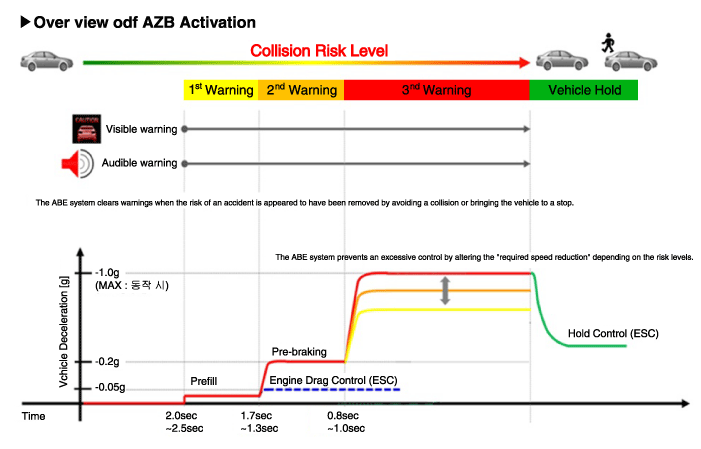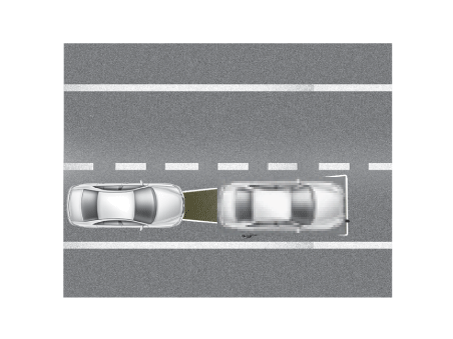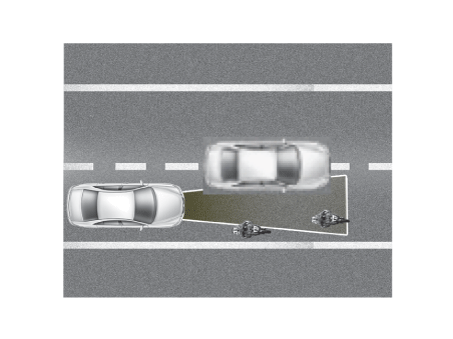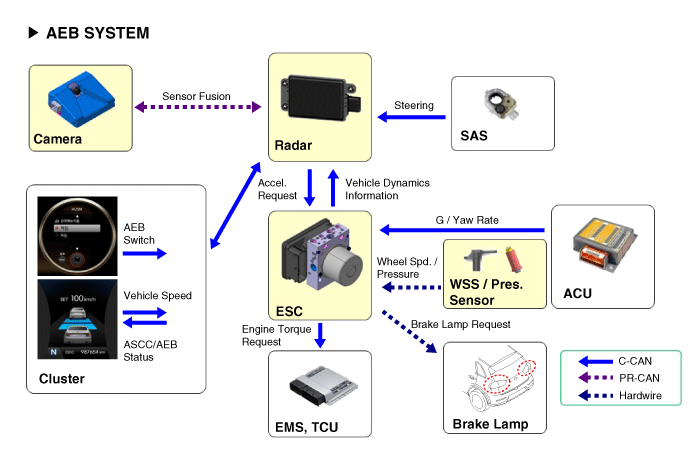Kia Niro: Assist Emergency Braking(AEB) System / Description and operation
| – |
AEB system is designed to help avoid a potential collision or reduce
its impact when drivers applies inadequate, delayed or no brakes at all
to avoid a collision.
|
| – |
The system detects the risk factors on the road by using the frontal
impact sensor and warn the driver and activate the emergency brake to prevent
collision or reduce collision speed.
|
The following is the system control process
| 1. |
Detect preceding vehicles (pedestrians) and analyze the data (CAN comm.)
by using the radar sensor of the Smart Cruise Control System (SCC) and the
camera sensor of Lane Departure Warning System (LDWS).
|
| 2. |
Confirm the object to be protected by AEB system (vehicles and pedestrians)
by using the analyzed data.
|
| 3. |
Calculate the speed reduction depending on the speed, distance, existence
or nonexistence of preceding vehicle.
|
| 4. |
Report the "required speed reduction" to Vehicle Dynamics Control (VDC)
(CAN Comm.)
|
| 5. |
VDC performs automatic control after calculating the required torque
to achieve "required speed reduction" (CAN Comm.).
|

? The time indicated will be changed according to vehicle speeds.
| • |
Step 1: Issue a visual (display) and vocal alarm when a danger is detected.
|
| • |
Step 2: Reduce engine torque and activates AEB when there is a high chance
of collision.
|
| • |
Step 3: Activate emergency brake when a collision is imminent.
|
| • |
After stopping the vehicle: Maintain the braking control for a certain
time and then release it.
|
| • |
Braking power is adjusted depending on the risk levels of collision,
but it is released immediately when it detects the driver's action
to avoid a collision.
|
| 1) |
When it exceeded the maximum operation speed.
|
| 2) |
When it detected driver's action to avoid a collision such as
sudden steering changes.
|
| 3) |
When the shift lever is in R or P
|
| 4) |
When you pressed the accelerator pedal half way.
|
|
| 1) |
When you drive at 80km/h or faster, the system does not go to
step 3 of emergency braking.
|
| – |
Full auto braking is not available.
|
| 2) |
While driving at 80km/h or slower on a straight or slightly curved
road, the system performs three steps after issuing a warning.
|
| – |
But a collision may occur at 30km/h or faster depending on the
road conditions.
|
| 3) |
While driving at 80km/h or slower on a straight or slightly curved
road, after a visual and vocal warning, AEB is activated to reduce
the vehicle speed.
|
| 4) |
At 80km/h or faster, it's impossible to avoid a collision. Offset
should be less than 50%.
|
| 5) |
AEB does not work on the vehicles backing up or resisting.
|
| 6) |
At 70km/h or faster, it does not respond to pedestrians.
|
|
| • |
Offset : Rate of non-overlapping on the line between the front
driving car and my car
|
| 1) |
Offset 0% :

|
| 2) |
Offset 100% :

|
|
The following is the
configuration of the AEB system.
| – |
Detection device (radar and camera) that can recognize potential obstacles
in the front.
|
| – |
Human-Machine Interface (HMI) to warn driver or change settings.
|
| – |
Braking system to automatically brake the car
AEB, contrary to SCC (Smart Cruise Control), has to work on a stationary
car so the system uses the Fusion Target system to combine radar with camera.

|
Schematic diagram
Terminal Function
NO.
Terminal function
1
B+
2
NC
...
Other information:
Kia Niro (DE HEV) Owners Manual: Economical operation
Your vehicle's fuel economy depends mainly on your style of driving, where you
drive and when you drive.
Each of these factors affects how many kilometers (miles) you can get from a
liter (gallon) of fuel.To operate your vehicle as economically as possible, use
the following driving sugge ...
Kia Niro 2017 (DE HEV) Service Manual: Components and components location
Component Location Index
[Engine Room]
1. Ambient Temperature Sensor
2. Receiver-drier
3. Condenser
4. Compressor
5. Discharge hose
6. The service port (voltage)
7. The service port (high pressure)
8. A/C Pressure Transducer (APT)
...

 Schematic diagrams
Schematic diagrams





